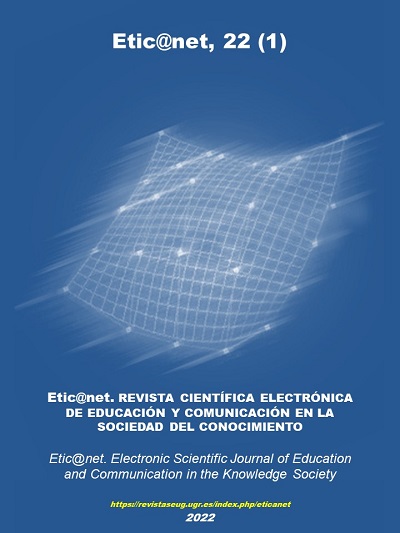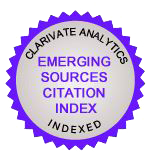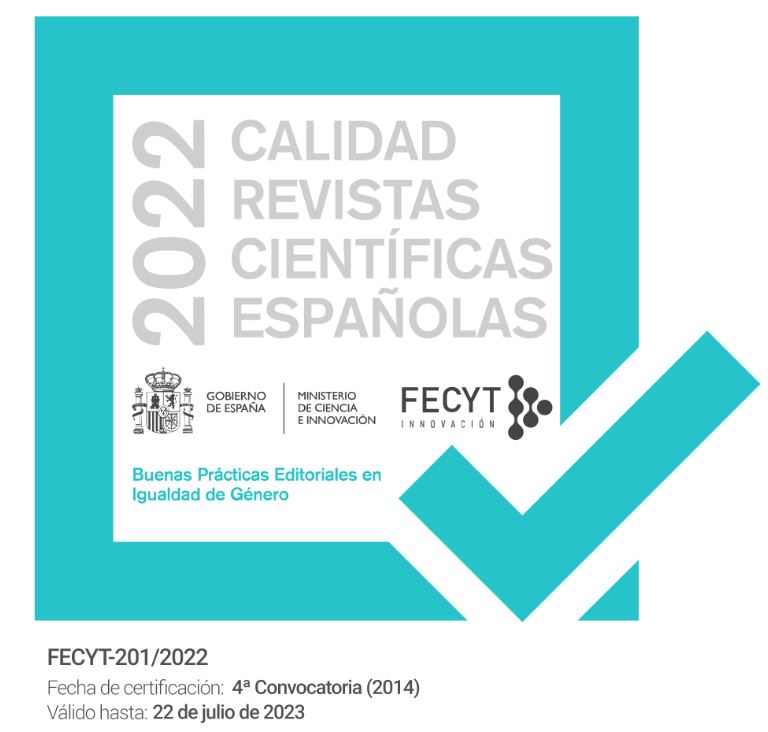The role of interactive digital storytelling in media and communication literacy processes
DOI:
https://doi.org/10.30827/eticanet.v22i1.24065Keywords:
Digital communication, media literacy, data visualization, digital storytellingAbstract
This paper analyzes the importance assumed by digital narratives in higher education fields, as a way to promote media and digital literacy among students and contribute to the development of skills related to their ability to critically analyze the information they receive from their environment. We consider that, in a context such as the current one, characterized by information saturation and the spread of different forms of disinformation, the development of this type of competencies is especially important.
For this purpose, this study analyzes the capabilities offered by interactive digital stories in the field of education, reviewing in particular the characteristics of ThingLink, StoryMapJS and Flourish, three of the main tools for the creation of this type of content. This analysis starts by considering the possibilities offered by the development and creation of this type of narratives in order to favor a critical positioning regarding digital information and the awareness of students about the importance of developing truthful, reflective and evidence-based forms of communication.
Downloads
References
Abbott, H. P. (2020). The Cambridge introduction to narrative. Cambridge University Press.
Alterio, M. y McDrury, J. (2003). Learning through storytelling in higher education: Using reflection and experiencie to improve learning. Routledge.
Andaluz, L. (2021). Medidas preventivas en contra de la de desinformación en Europa. En M. Blanco Pérez (Coord.), El progreso de la comunicación en la era de los prosumidores (pp. 171-194). Dykinson.
Brown, J., Bryan, J., & Brown, T. (2005). Twenty-first century literacy and technology in K-8 classrooms. Innovate: Journal of Online Education, 1(3). https://www.learntechlib.org/p/107300/
Bruner, J. (1991). Actos de significado. Alianza.
Calvo, S. T., y Perceval, J. M. (2006). El cuento multimedia interactivo. Comunicar: Revista científica iberoamericana de comunicación y educación, (26), 177-182. https://doi.org/10.3916/C26-2006-27
Card, S. K., Mackinlay, J. D., & Shneiderman, B. (1999). Readings information visualization: using vision to think. Morgan Kaufmann.
Derrida, J. (2007). La diseminación. Madrid, España: Editorial Fundamentos.
Díaz, A. (2008). El profesor de educación superior frente a las demandas de los nuevos debates educativos. En Perfiles Educativos, 27(108), 9-30. http://www.scielo.org.mx/scielo.php?script=sci_arttext&pid=S0185-26982005000100002&lng=es&nrm=iso
Fernández, Á., Revilla, A., y Antón, L. (2020). Análisis de la caracterización discursiva de los relatos migratorios en Twitter. El caso Aquarius. Revista Latina de Comunicación Social, (77), 1-18. https://doi.org/10.4185/RLCS-2020-1446
Fernández, Á. (2017). Relatos híbridos: El papel de la narratividad en la visualización de información interactiva [Tesis doctoral, Universidad Europea]. Repositorio Abacus https://193.147.239.238/handle/11268/6981
Gazapo, B. y Fernández, A. (2015). Geopolítica de la energía y el conflicto: una propuesta interdisciplinar de narrativa digital aplicada a la Educación Superior. En Educar parar transformar: aprendizaje experiencial (pp. 575-580). Universidad Europea. http://hdl.handle.net/11268/4462
Gershon, N., & Page, W. (2001). What storytelling can do for information visualization. Communications of the ACM, 44(8), 31-37. https://doi.org/10.1145/381641.381653
Hibbing, A. N., & Rankin-Erickson, J. L. (2003). A picture is worth a thousand words: Using visual images to improve comprehension for middle school struggling readers. The reading teacher, 56(8), 758-770. http://www.jstor.org/stable/20205292.
Jakes, D. (2006). Standards-proof your digital storytelling
efforts. TechLearning. http://www.techlearning.com/story/showArticle.jhtml?articleID=180204072
Jannidis, F., Kindt, T., & Müller, H. H. (2003). What Is Narratology? Questions and Answers Regarding the Status of a Theory.
Kosara, R., & Mackinlay, J. (2013). Storytelling: The next step for visualization. Computer, 46(5), 44-50. https://research.tableau.com/sites/default/files/Kosara-Computer-2013.pdf
Mitchell, W. J. (1981). On Narrative. Journal of Aesthetics and Art Criticism, 41 (4), 456-461. https://doi.org/10.2307/429884
Nussbaumer, C. (2015). Storytelling with data: a data visualization guide for business professionals. John Wiley & Sons, Inc.
Pérez, Á., Sacaluga, I. y Moreno, A. (2021). The Development of the Competency of “Cultural Awareness and Expressions” Using Movie-Induced Tourism as a Didactic Resource. Education Sciences, 11, 315.
https://doi.org/10.3390/educsci11070315
Robertson, G. G., Card, S. K., & Mackinlay, J. D. (1993). Information visualization using 3D interactive animation. Communications of the ACM, 36(4), 57-71. https://dl.acm.org/doi/pdf/10.1145/255950.153577
Rodríguez, J. L., & Londoño, G. (2009). Los relatos digitales y su interés
educativo. Educação, Formação & Tecnologias, 2(1), 5-18. http://eft.educom.pt.
Robin, B. R. (2008). Digital storytelling: A powerful technology tool for the 21st century classroom. Theory into practice, 47(3), 220-228. http://dx.doi.org/10.1080/00405840802153916
Segel, E. y Heer, J. (2010). Narrative visualization: Telling stories with data.
Visualization and Computer Graphics, IEEE Transactions on, 16(6), 1139-1148. https://doi.org/10.1109/TVCG.2010.179
UNESCO. (2019, 8 de marzo). Información falsa: La opinión de los periodistas [revista online]. Unesco. http://bit.ly/2O6mbDv
Vargas, J.J. y Sacaluga, I. (2021). Neurocomunicación visual consciente: gestión deliberada y potencial de la mirada, como argumento persuasivo no verbal para vencer y convencer. Anales de Investigación, 17(3), edición especial 1-13. http://revistas.bnjm.cu/index.php/BAI/article/view/453
Ware, C. (2004). Information Visualization: Perception for Design, Morgan Kaufmann.
Published
Issue
Section
License
The authors who publish in this journal agree to the following terms: The authors retain the copyright and grant the journal the right to be the first publication of the work as well as licensed under a Creative Commons Attribution License that allows others to share the work with an acknowledgment of the authorship of the work and the initial publication in this magazine. Authors are allowed and encouraged to disseminate their work electronically (for example, in institutional repositories or on their own website) before and during the submission process, as it may lead to productive exchanges as well as further citation. Earliest and greatest of published works (See The Effect of Open Access).














